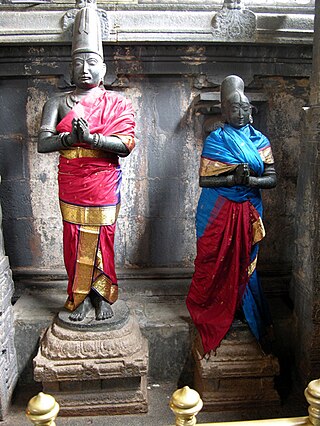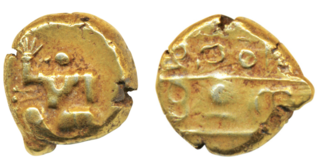
Krishnadevaraya was an emperor of the Vijayanagara Empire reigning from 1509 to 1529. He was the third monarch of the Tuluva dynasty, and is considered to be one of the greatest rulers in Indian history. He ruled the largest empire in India after the fall of the Islamic Delhi Sultanate. Presiding over the empire at its zenith, he is regarded as an icon by many Indians. Krishnadevaraya earned the titles Andhra Bhoja, Karnatakaratna Simhasanadeeshwara, Yavana Rajya Pratistapanacharya, Kannada Rajya Rama Ramana, Gaubrahmana Pratipalaka and Mooru Rayara Ganda. He became the dominant ruler of the peninsula by defeating the sultans of Bijapur, Golconda, the Bahmani Sultanate and the Gajapatis of Odisha, and was one of the most powerful Hindu rulers in India.

Achyuta Deva Raya was an emperor of Vijayanagara who succeeded his older brother, Krishnadevaraya, after the latter's death in 1529 CE.

Rama Raya was a statesman of the Vijayanagara Empire, the son-in-law of Emperor Krishna Deva Raya and the progenitor of the Aravidu dynasty of Vijayanagara Empire, the fourth and last dynasty of the empire. As a regent, he was the de facto ruler of the empire from 1542 to 1565, although legally the emperor during this period was Sadasiva Raya, who was merely a puppet ruler. Rama Raya was killed at the Battle of Talikota, after which the Vijayanagara Empire got fragmented into several semi-independent principalities paying only nominal allegiance to the empire.

BukkaRaya I was an emperor of the Vijayanagara Empire from the Sangama Dynasty. He was a son of Bhavana Sangama, the chieftain of a cowherd pastoralist community, Yadava people|Golla]] descent. The first Bahmani-Vijayanagar War was occurred during the reign of Bukka Raya I, in which he was besieged, and sued for peace.

Penukonda also called Penugonda is a town in the Sri Sathya Sai district of Andhra Pradesh, India. It is 70 km away from Anantapur town.

The Thanjavur Nayakdynasty were the rulers of Thanjavur in the 15th and 17th centuries. The Nayaks, who belonged to the Telugu-speaking Balija social group were originally appointed as provincial governors by the Vijayanagara Emperor in the 15th century, who divided the territory into Nayak kingdoms which were Madurai, Tanjore, Gingee and Kalahasthi. In the mid-15th century they became an independent kingdom, although they continued their alliance with the Vijayanagara Empire. The Thanjavur Nayaks were notable for their patronage of literature and the arts.
Tuluva Narasa Nayaka was an Indian general a Bunt chieftain and later an Imperial Regent who founded the Tuluva dynasty of the Vijayanagara Empire. He was the father of the Emperors Viranarasimha Raya, Krishnadevaraya and Achyuta Deva Raya.
The Aravidu Dynasty was the fourth and last Hindu dynasty of Vijayanagara Empire in South India. Its founder was Tirumala Deva Raya, whose brother Rama Raya had been the masterful regent of the last ruler of the previous dynasty. Rama Raya's death at the Battle of Talikota in 1565 led to the subsequent destruction of Vijayanagar by the combined forces of the Muslim states of the Deccan. The Aravidu family claimed to be Kshatriyas and were based in Andhra region. They claimed to belong to the Atreya gotra and traced their lineage to the Eastern Chalukya king Rajaraja Narendra.
Sadasiva Raya was an Emperor of Vijayanagara who reigned from 1542 to 1570 CE. When the Vijayanagara Emperor Achyuta Raya died in 1542 CE, his son, Venkata I, succeeded him. However, Venkata I was assassinated six months later. Sadasiva Raya, who was the nephew of Achyuta Raya, became the new Emperor in accordance with the Aliya succession laws which was prevalent among the Tuluvas. Sadasiva Raya, along with his Prime Minister Rama Raya, restored the Vijayanagara empire's power, which had diminished after the reign of Krishna Deva Raya. The strategy was to play the Turko-Persian Sultanates in the Deccan against each other by first allying with one and then another.
Sriranga II was nominated in 1614 by Emperor Venkata II to succeed him as the Emperor of Vijayanagara. Sriranga was supported by a faction headed by Yachama Nayaka of Recherla Velama dynasty, one of the Venkata II's loyal viceroys and commanders and Nayak of Venkatagiri, but was not favored by a set of nobles headed by Gobburi Jagga Raya, brother of Venkata II's favourite Queen Obayamma.
Rama Deva Raya ascended the throne after a gruesome war in 1617 as the King of Vijayanagara Empire. In 1614 his father, Sriranga II the preceding King and his family were gruesomely murdered by rival factions headed by Jagga Raya, who was one of their kins. Rama Deva himself was smuggled out of the prison by Yachama Naidu, a faithful commander and the viceroy of earlier king Venkata II.
Sriranga III was the last ruler of the Vijayanagara Empire, who came to power in 1642 following the death of his uncle Venkata III. He was also a great grandson of Aliya Rama Raya.
Sriranga Deva Raya was the second Emperor of Vijayanagara from the Aravidu Dynasty. He reigned the empire from the fortress of Penukonda. Sriranga succeeded his father, Emperor Tirumala Deva Raya. After the fall of Vijayanagara to Turko-Persian Sultanates of Deccan, he carried out the restoration of the empire from Penukonda. His reign was marred with repeated invasions and subsequent losses of territory to his Turko-Persian Muslim neighbours.

Venkatapati Raya was the third Emperor of Vijayanagara from the Aravidu Dynasty. He succeeded his older brother, the Emperor Sriranga Deva Raya as the ruler of Vijayanagara Empire with bases in Penukonda, Chandragiri and Vellore. His reign of nearly three decades saw a revival in the strength and prosperity of the empire. He successfully dealt with the Turko-Persian Deccan sultans of Bijapur and Golkonda, the internal disorders, promoting economic revival in the realm. He subdued the rebelling Nayakas of Tamil Nadu and parts of present-day Andhra Pradesh.

Venkata III was the grandson of Aliya Rama Raya. Venkata III belonged to a Telugu family and became the King of the Vijayanagara Empire from 1632 to 1642. His brothers-in-law were Damarla Venkatappa Nayaka and Damarla Ayyappa Nayaka, both sons of Damarla Chennapa Nayakadu.

The Nayakas of Kalahasti were a line of rulers of Kalahasti and Vandavasi principalities. Members of the group include Damarla Chennapa Nayaka, after whom the city of Chennai is named. The Kalahasti Nayaks had their origins in the Velama warrior clans of present-day Andhra Pradesh. These Nayakas served as vassals of the late Vijayanagara Empire, then held by the Aravidu Dynasty and headquartered at Chandragiri and Vellore.
Venkata I was an Emperor of Vijayanagara from the Tuluva Dynasty. He was the son of Emperor Achyuta Deva Raya, whom he succeeded in 1542 CE.
Gobburi Jagga Raya was a de facto King of Vijayanagara Empire on behalf adopted nephew named Chenga Raya, a rival claimant to the Vijaynagara thorne. He was the brother of Venkata II's favourite Queen Obayamma who was bequeathed the Pulicat region and belonged to the Gobburi family of Nayaks under the Vijayanagar Empire.
Damarla Chennapa Nayaka was a Nayaka ruler of Kalahasti and Vandavasi under the suzerainty of Vijayanagar emperor Venkatapati Raya. He was also the Dalavoy or the Commander-in-Chief of the emperor.
This battle caused complete destruction of the already declining Vijayanagara Empire. It was a civil war fought by the claimants for the kingship of the Vijayanagara Empire. Jagga Raya challenged the Sriranga Authority on behalf of his nephew.








